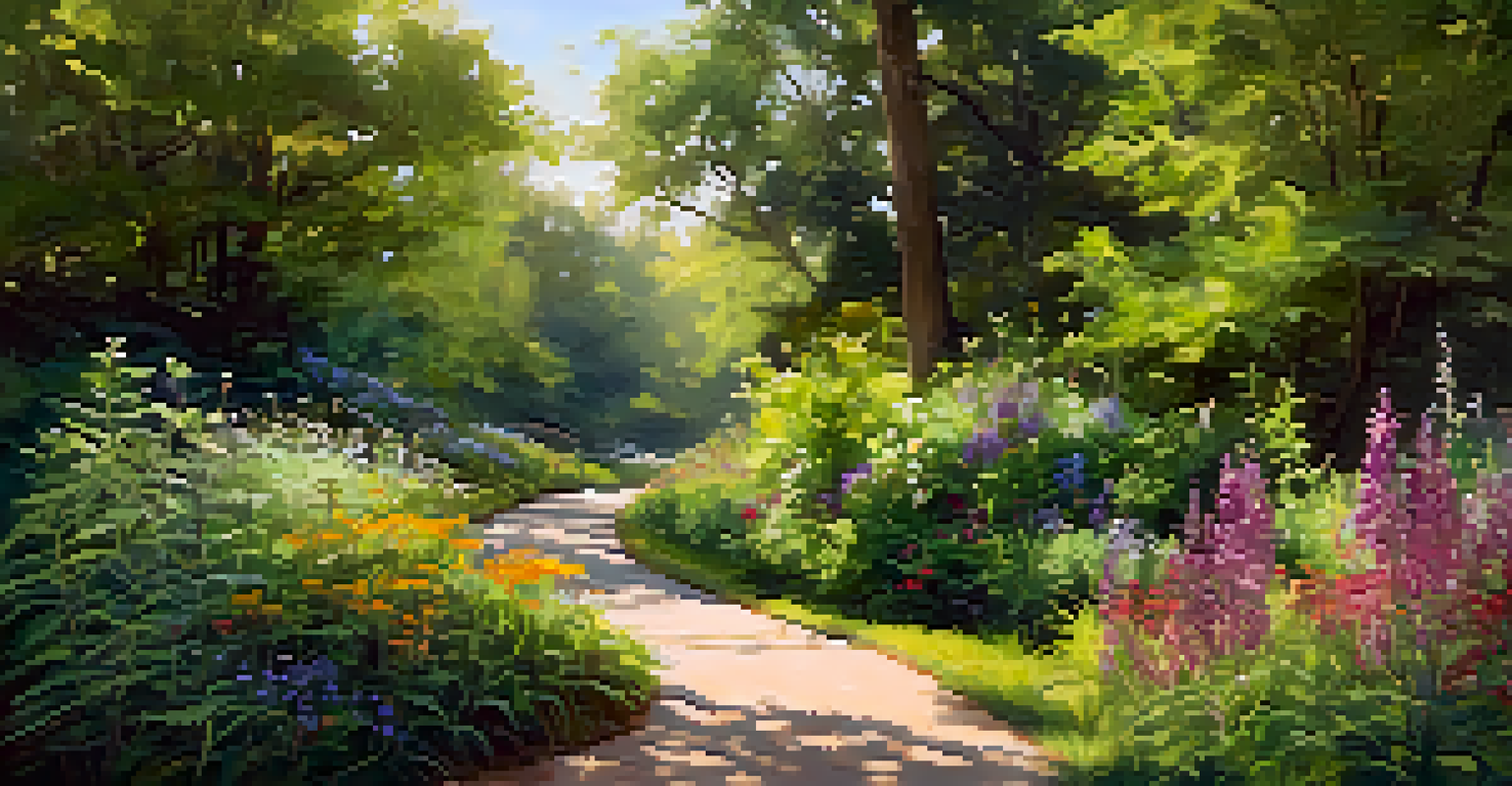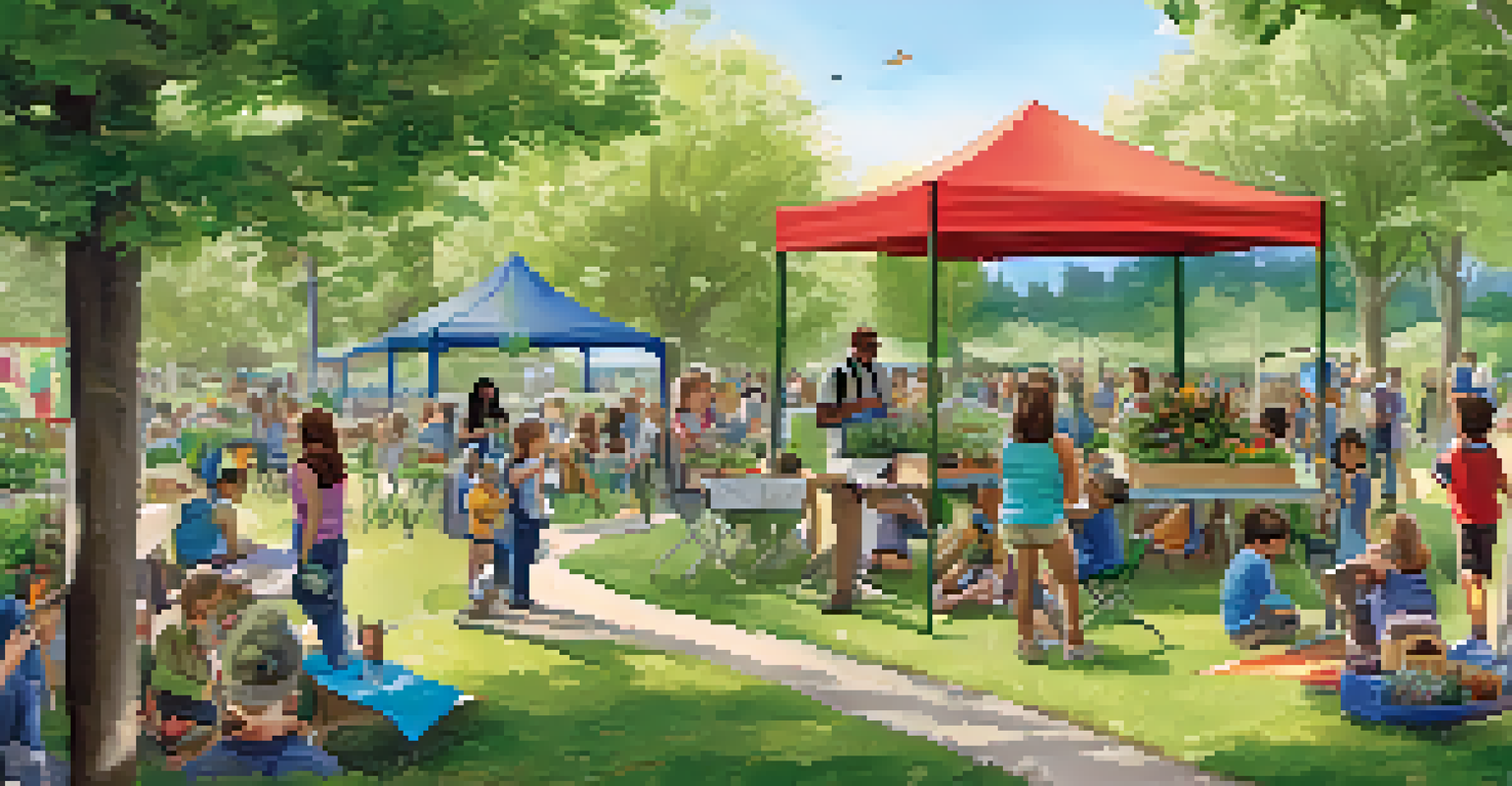Charlotte's Urban Parks: Vital Spaces for Biodiversity

The Role of Urban Parks in Biodiversity
Urban parks serve as essential green spaces that support various forms of wildlife. In a bustling city like Charlotte, these parks become critical habitats for birds, insects, and even small mammals. They provide a refuge where these species can thrive away from the noise and pollution of urban life.
In every walk with nature one receives far more than he seeks.
By maintaining diverse ecosystems, urban parks help to preserve the delicate balance of nature. For example, parks with a mix of trees, shrubs, and wildflowers can host a variety of pollinators, which are crucial for plant reproduction. This diversity also enhances the resilience of these ecosystems against diseases and changing climate conditions.
Moreover, urban parks contribute to the overall health of the community. They not only offer residents a space to relax and enjoy nature but also educate them about local wildlife. This awareness fosters a greater appreciation for biodiversity and encourages community involvement in conservation efforts.
Key Parks Supporting Biodiversity in Charlotte
Charlotte boasts several parks that play a significant role in supporting biodiversity. For instance, Freedom Park, with its expansive green spaces and a large lake, serves as a major habitat for migratory birds. Visitors can often spot herons, ducks, and even the occasional eagle soaring overhead.

Another notable example is the Little Sugar Creek Greenway, which incorporates natural habitats along its path. This greenway offers a corridor for wildlife movement, allowing species to thrive while connecting different habitats. Additionally, its native plant landscaping attracts a variety of pollinators, further enhancing local biodiversity.
Urban Parks Boost Local Biodiversity
Urban parks like Freedom Park and McAlpine Creek Park serve as vital habitats for various wildlife, supporting biodiversity in bustling cities.
Lastly, the McAlpine Creek Park features wetlands that are essential for amphibians and other aquatic life. These wetland areas not only provide critical breeding grounds but also help filter water, improving the overall ecosystem health. Such parks highlight the importance of maintaining diverse environments within urban settings.
The Benefits of Biodiversity in Urban Areas
Biodiversity in urban areas like Charlotte offers numerous benefits that extend beyond aesthetics. A rich variety of species contributes to ecosystem services such as pollination, water purification, and even climate regulation. These services are vital for maintaining the urban environment's health and sustainability.
The clearest way into the Universe is through a forest wilderness.
Moreover, diverse ecosystems can improve the quality of life for residents. They provide opportunities for recreation, relaxation, and education, fostering a sense of community connection to nature. Parks with rich biodiversity often attract visitors, which supports local businesses and enhances community pride.
On a broader scale, urban biodiversity can help combat climate change. Healthy ecosystems are better equipped to absorb carbon dioxide and mitigate the urban heat island effect. This not only benefits the environment but also creates a more livable city for future generations.
Community Engagement in Urban Biodiversity
Engaging the community in urban biodiversity initiatives is crucial for their success. Programs that involve residents in park clean-ups, tree planting, and wildlife monitoring help foster a sense of ownership and responsibility towards these green spaces. This hands-on involvement can lead to lasting changes in community attitudes toward nature.
Local schools also play a pivotal role in promoting biodiversity awareness. Educational programs that incorporate field trips to parks or hands-on projects, like creating a school garden, can ignite children's interest in ecology. These experiences build a foundation for future environmental stewardship.
Community Engagement is Essential
Involving residents in biodiversity initiatives fosters a sense of ownership and responsibility towards local green spaces.
Moreover, community events such as biodiversity festivals or nature walks encourage residents to explore their local parks. These gatherings not only educate attendees about the importance of biodiversity but also cultivate relationships among neighbors, creating a stronger, more connected community.
Incorporating Native Plants in Urban Parks
One effective way to boost biodiversity in urban parks is through the use of native plants. Native species are well-adapted to the local climate and soil conditions, making them more resilient and easier to maintain. Additionally, they provide essential habitat and food for native wildlife, supporting the local ecosystem.
For example, planting native wildflowers can attract a variety of pollinators, such as bees and butterflies, which are crucial for maintaining plant diversity. This not only enhances the beauty of the parks but also creates a thriving environment for wildlife. Parks that prioritize native plants often see an increase in biodiversity and ecological health.
Furthermore, native plants require less water and fewer chemical inputs, making them more sustainable choices for urban landscaping. By advocating for the use of native flora, Charlotte can lead the way in creating parks that are not only beautiful but also ecologically beneficial.
The Role of Urban Wildlife Corridors
Urban wildlife corridors are essential for connecting fragmented habitats, allowing species to move freely across the city. In Charlotte, these corridors can help link parks and natural areas, providing critical pathways for wildlife. This connectivity is vital for maintaining genetic diversity and allowing species to adapt to changing environments.
For instance, the creation of greenways along rivers and streams helps facilitate the movement of aquatic and terrestrial species. These corridors not only support wildlife but also enhance recreational opportunities for residents, such as walking, cycling, or birdwatching. They serve as vital links between urban areas and natural habitats.
Native Plants Enhance Ecosystem Health
Incorporating native plants in urban parks supports local wildlife and promotes ecological resilience while requiring less maintenance.
Moreover, urban wildlife corridors can mitigate the effects of urbanization on local ecosystems. By preserving these pathways, cities can encourage biodiversity while promoting sustainable urban development. This approach ensures that nature and urban life can coexist harmoniously, benefiting both wildlife and residents.
Future Initiatives for Biodiversity Preservation
Looking ahead, Charlotte can implement various initiatives to further enhance urban biodiversity. Strategies such as creating more green roofs, urban gardens, and pocket parks can provide additional habitats for wildlife. These initiatives not only improve biodiversity but also enhance the city's aesthetic appeal and livability.
Collaboration with local organizations and community members can also drive biodiversity efforts. By partnering with environmental groups, Charlotte can develop programs focused on conservation, education, and habitat restoration. Engaging the community in these efforts fosters a shared responsibility for protecting local ecosystems.

Finally, incorporating biodiversity goals into city planning can ensure that future developments consider ecological impacts. By prioritizing green spaces and sustainable practices, Charlotte can create a vibrant urban environment that supports both its residents and the diverse species that call it home.